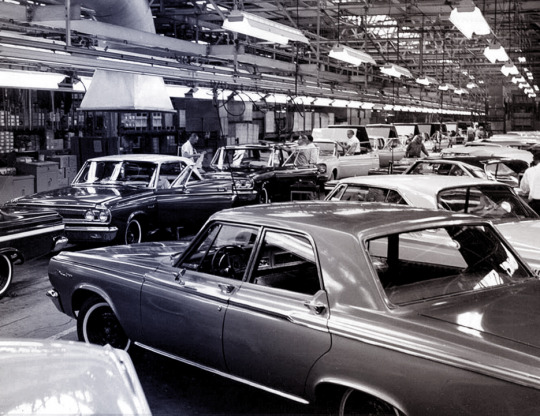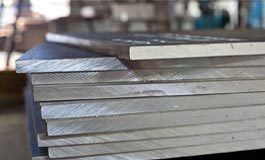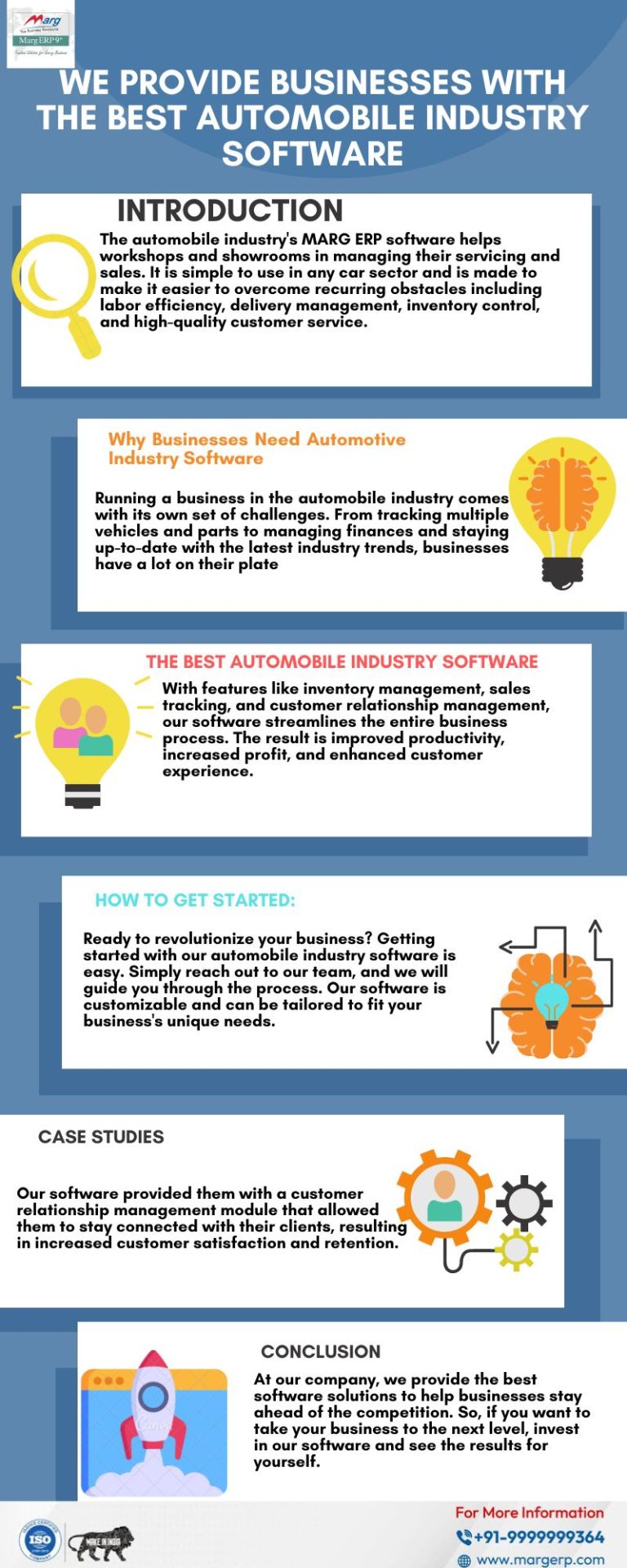#Automobile Industry
Text
Over 10,000 Chrystler-Fiat vehicles are being recalled in Canada due to the potential for a defective airbag.
“On certain vehicles, the side curtain airbag inflators could be defective,” Transport Canada’s recall reads.
“As a result, the driver and/or passenger side curtain airbag inflator(s) could rupture unexpectedly and metal fragments could be propelled toward vehicle occupants.”
The recall was initially posted March 14 but was updated Friday. It involves the 2018-2021 models of the Chrysler 300 and the Dodge Charger, totalling 10,285 units. [...]
Date of article: March 22nd 2024.
Continue Reading.
Tagging: @politicsofcanada
28 notes
·
View notes
Text

From the car files: the 1965 Dodge Coronet assembly line.
#the 60s#1965#coronet#65 coronet#1965 dodge#1965 coronet#detroit#car assembly line#detroit assembly line#1965 dodge coronet#automobile industry#automotive industry
8 notes
·
View notes
Text

I asked the Artificial Intelligence app based on Machine Learning to imagine something, in the image above the result obtained.
I didn't know this car, a middle ground between the sports car and some other style that I can't define now, apparently related to the automobile industry in the United States of America, and perhaps it has been modified at least in the tires, they don't look original from factory.
The basic modifications that a car owner made to make it more modern and sporty were known to anyone who had any interest in cars, replacing: the steering wheel, the tires, the exhaust outlet, the windows, the seats, ... that huge industry and trade in accessories that try to suggest that they are better than the engineers who worked at or for the automobile factory, I realize that to this day this dispute is not over.
Where am I on this?
I really don't know if my interest in Mechanical Engineering came before or after my interest in Electronic Engineering, but it was before the subject of Mechatronics, a mixture of Mechanics and Electronics.
If there is a collision of galaxies where we live, only pieces of extinct civilizations will survive.
2 notes
·
View notes
Text
Plastic: It used to be a star substance. ~ Curse of Minamata disease (chemistry-6)

south-west of Kumamoto prefecture
Recently, it has become a hot topic that microplastics, which are shattered into small pieces, are harmful to the environment and wildlife. , is fresh in my memory.
However, plastic was touted as a "dream material" in the early stages of its development and commercialization.
It was used as an adjective meaning that "it can be shaped" = "it has plasticity", and the noun "plastic" was born.
The great attraction of plastic was its plasticity, which allows it to change its shape into any shape. In the plastic industry, plastics that can be freely shaped like this are produced by a method called injection molding, but the plastic industry is widely regarded as a "subcontractor" for the automobile industry, and is "scorned" by the automobile industry. "The fact is that we are operating.
Here, there is an unexpected connection between plastic and Minamata disease. One of my mentors, the master of pollution problems: The late Mr. Jun Ui was a student during Japan's period of high economic growth. Of these, only the top students were hired by Minamata Chisso. Today, it is a poor company whose life is being extended to help Minamata disease patients, but it used to be a super-elite group. The Chisso Minamata Factory produced a wide variety of agricultural materials and was a strong supporter of farmers' farm work. They also made vinyl for greenhouses and black mulch (a material that covers the soil, keeps it warm, and retains water).
Well, when making such plastics, Hg (mercury) was used as a catalyst (the substance itself does not change before and after the reaction, but it is essential to cause a chemical reaction). As anyone with a sharp intuition can guess, this mercury degrades to methylmercury, and it has been accumulated over many years that factory effluent containing this substance was discharged into Minamata Bay as it is without any water purification process. This led to the outbreak of methylmercury poisoning, known as Minamata disease.
#Plastic#Minamata disease#chemistry#microplastics#automobile industry#Jun Ui#Chisso#agricultural materials#rei morishita#Hg#methylmercury#Minamata Bay#catalyst
2 notes
·
View notes
Text
Jindal Stainless Steel Plate Manufacturers & Suppliers in Mumbai, India

#manufacturing#chemical industry#sugar industry#oil & gas#architecture#pharma industry#power plant#automobile industry
3 notes
·
View notes
Text

Leyat Hélica, a French automobile produced between 1919 & 1925.
5 notes
·
View notes
Text
Genesis G 90 2023

#genesis car's#genesis G90#genesis global capital#genesis global trading#manualwheel#sedan full size#carlovers#newcar#cars#new cars#luxury cars#tumbler tags#luxury#autos#carspotting#autombile#automobile industry#automobile#automotive
5 notes
·
View notes
Text
Two Wheeler Sales Supported Business During Covid — Debanjali Sengupta, Shell Lubricants India
Two Wheeler Sales Supported Business During Covid — Debanjali Sengupta, Shell Lubricants India
Shell has launched the Shell Advance Fuel Save 10W-30 lubricant in India today, focused on the two-wheeler segment. The Shell Advance 10W30 is engineered to enhance fuel economy and deliver monetary savings. The product provides savings of ~INR 2500 annually for daily riders who clock higher running hours/distance on the road.
The company claims that consumers can ride an additional 5 km per…

View On WordPress
#automobile industry#bike mileage#chip shortage#fuel economy#lubricant industry#oem&039;s#personal transport#pure plus technology#shell advance fuel save 10w-30 lubricant#shell lubricants india#swiggy#two-wheeler segment#zomato
2 notes
·
View notes
Text

In a world where every penny counts, finding the perfect balance between budget and quality is a pursuit many embark on. For the automotive enthusiasts among us, the quest for a reliable and Best car under 10 lakh rupees has never been more exciting. Let’s dive into the world of budget-friendly driving and explore the top picks that promise not just savings but an exhilarating driving experience.
0 notes
Text
Automobile Market Size, Share, Growth Forecast
The Automobile Industry:
A Driving Force in Economic Evolution
The automobile industry is a dynamic and ever-evolving sector that plays a pivotal role in shaping the global economy. From technological advancements to market trends and competitive landscapes, the automobile market is a multifaceted arena that demands close attention and analysis. In this blog, we delve into the intricacies of the automobile industry, exploring its size, trends, market share, and future forecasts.
Automobile Market Size and Market Share:
Quantifying Success
Quantifying the size and market share of the automobile industry requires a comprehensive examination of global and regional trends. The global automobile market size was worth around USD 2810.63 billion in 2022 and is predicted to grow to around USD 3969.84 billion by 2030 with a compound annual growth rate (CAGR) of roughly 4.42% between 2023 and 2030. As of the latest data, the industry boasts a colossal market size, fueled by the increasing demand for vehicles across diverse segments. From passenger cars to commercial vehicles and electric automobiles, the market is witnessing a paradigm shift, with emerging markets contributing significantly to its growth.

Automobile Industry Analysis:
Unveiling the Engine of Progress
The automobile industry, often referred to as the heartbeat of modern economies, encompasses a wide range of activities, including manufacturing, marketing, sales, and aftermarket services. The sector is characterized by constant innovation, with players vying to stay ahead in the race for technological supremacy. As we analyze the global scenario, it becomes evident that the industry is in the midst of a profound transformation, driven by factors such as electric vehicles, autonomous driving, and sustainability initiatives.
Automobile Sector:
A Comprehensive Look the Roadmap to Success
The automobile sector comprises various components, from manufacturers and suppliers to dealerships and service providers. Understanding the sector's dynamics involves dissecting the supply chain, regulatory frameworks, and consumer preferences. Moreover, the sector is witnessing a surge in collaborative efforts between traditional automakers and tech companies, ushering in an era of unprecedented partnerships that redefine the industry's landscape.
Automobile Market Forecast:
Navigating Future Horizons
Forecasting the future of the automobile market is akin to predicting the trajectory of a speeding car – challenging but essential. The integration of artificial intelligence, connectivity, and sustainability measures is poised to redefine the industry. As we peer into the crystal ball, electric vehicles are expected to play a pivotal role, with governments worldwide incentivizing their adoption and driving a surge in market demand.
Automobile Market Trends:
Riding the Waves of Change
Trends in the automobile market are as dynamic as the vehicles themselves. From the rise of electric and hybrid technologies to the growing popularity of shared mobility solutions, industry trends shape the decisions of both manufacturers and consumers. The ongoing emphasis on sustainability, safety features, and connected car technologies further underscores the ever-evolving nature of the industry.
Automobile Market in India:
A Kaleidoscope of Opportunities
India, one of the world's largest and fastest-growing economies, occupies a prominent place in the global automobile market. As we explore the automobile market share in India, we unravel the success stories of the largest automobile companies in the country. The growth of the automobile industry in India is not only a testament to the nation's economic prowess but also a reflection of the changing aspirations of its burgeoning middle class.
Conclusion:
Driving into the Future
In conclusion, the automobile market is a vast and dynamic ecosystem that continues to redefine itself with each passing day. From market size and trends to forecasts and regional analyses, understanding the intricacies of the industry is crucial for stakeholders aiming to navigate the fast lane of economic evolution. As technology continues to push the boundaries of what is possible, the automobile market stands at the crossroads of innovation, sustainability, and unparalleled growth. Buckle up as we embark on a journey into the future of mobility.
0 notes
Text
The automotive industry comprises a wide range of companies and organizations involved in the design, development, manufacturing, marketing, selling, repairing, and modification of motor vehicles. It is one of the world's largest industries by revenue.The word automotive comes from the Greek autos (self), and Latin motivus (of motion), referring to any form of self-powered vehicle. This term, as proposed by Elmer Sperry.First came into use with reference to automobiles in 1898.
History:
The automotive industry began in the 1860s with hundreds of manufacturers pioneering the horseless carriage. Early car manufacturing involved manual assembly by a human worker. The process evolved from engineers working on a stationary car, to a conveyor belt system where the car passed through multiple stations of more specialized engineers. Starting in the 1960s, robotic equipment was introduced to the process, and today most cars are produced largely with automated machinery.
For many decades, the United States led the world in total automobile production, with the U.S. Big Three General Motors, Ford Motor Company and Chrysler being the world's three largest auto manufacturers for a time, and G.M. and Ford remaining the two largest until mid-2000s. In 1929, before the Great Depression, the world had 32,028,500 automobiles in use, of which more than 90% produced by the U.S. automobile industry. At that time, the U.S. had one car per 4.87 persons.
Notable company relationships:
Daihatsu holds a 25% stake in Perodua.
Daimler holds a 10.0% stake in KAMAZ.
Daimler holds an 89.29% stake in Mitsubishi Fuso Truck and Bus Corporation.
Daimler holds a 3.1% in the Renault-Nissan Alliance, while Renault-Nissan Alliance holds a 3.1% share in Daimler AG.
Daimler holds a 12% stake in BAIC Group, while BAIC Group holds 5% stake in Daimler.
Daimler holds an 85% stake in Master Motors.
Dongfeng Motor holds a 12.23% stake and a 19.94% exercisable voting rights in PSA Groupe.
FAW Group owns 49% of Haima Automobile.
FCA holds a 10% stake in Ferrari.
FCA holds a 67% stake in Fiat Automobili Srbija.
FCA holds 37.8% of Tofaş with another 37.8% owned by Koç Holding.
1 note
·
View note
Text
#car appraisal service#vehicle appraisal service#auto appraisal service#motor appraisal service#vancouver#british columbia#certified quick car appraisals#provincial sales tax#car appraisal#auto appraisal#cqca#car#auto#used cars#automobile#motor car#automotive industry#automobile industry#sale car#ICBC#Victoria
0 notes
Text
Mastering the Arc: A Comprehensive Guide to Welding Facilities and Procedures
Introduction:
Welding is a vital skill in many industries, from construction to automotive manufacturing. Whether you're a beginner or an experienced welder, understanding welding facilities and procedures is crucial for achieving quality welds safely. In this comprehensive guide, we'll delve into the world of welding facilities and procedures, providing you with essential knowledge to master the arc.
Understanding Welding Facilities:
Welding facilities refer to the physical spaces where welding operations take place. These facilities can vary widely depending on the scale of the project and the specific welding techniques used. Common components of welding facilities include:
Work Area: A designated space where welding activities occur. This area should be well-ventilated and free from flammable materials to ensure safety.
Welding Equipment: This includes welding machines, electrodes, protective gear such as helmets and gloves, as well as auxiliary tools like clamps and brushes.
Power Source: Welding machines require a stable power source, typically electricity or compressed gases such as oxygen and acetylene.
Safety Measures: Welding facilities should be equipped with fire extinguishers, first aid kits, and emergency exits to mitigate potential hazards.
Safety Procedures:
Safety should always be a top priority when welding. Here are some essential safety procedures to follow:
Wear Protective Gear: Always wear appropriate personal protective equipment (PPE) such as welding helmets, gloves, and flame-resistant clothing to protect yourself from sparks, UV radiation, and molten metal.
Ventilation: Ensure adequate ventilation in the welding area to prevent the buildup of harmful fumes and gases.
Inspect Equipment: Regularly inspect welding equipment for damage or defects, and ensure proper maintenance to prevent accidents.
Follow Operating Instructions: Familiarize yourself with the operating instructions of welding machines and tools, and adhere to safety guidelines provided by manufacturers.
Fire Prevention: Keep flammable materials away from the welding area, and have fire extinguishing equipment readily available in case of emergencies.
Common Welding Procedures:
Several welding techniques are used in various industries, each with its unique procedures. Some common welding procedures include:
Shielded Metal Arc Welding (SMAW): Also known as stick welding, SMAW involves the use of a flux-coated electrode to create welds. The electrode melts and forms a protective gas shield around the weld pool, preventing contamination.
Gas Metal Arc Welding (GMAW): Also referred to as MIG welding, GMAW uses a continuous wire electrode and a shielding gas to create strong welds. This process is versatile and suitable for welding a wide range of materials.
Gas Tungsten Arc Welding (GTAW): GTAW, or TIG welding, utilizes a non-consumable tungsten electrode and a separate filler material to create precise welds. This process is commonly used for thin materials and critical welds.
Flux-Cored Arc Welding (FCAW): FCAW combines elements of both stick and MIG welding, using a tubular wire electrode with flux inside. This process is ideal for outdoor welding and works well on dirty or rusty materials.
Submerged Arc Welding (SAW): SAW involves the formation of welds beneath a layer of granular flux, which protects the molten weld pool from atmospheric contamination. This process is highly efficient for welding thick materials in a single pass.
Conclusion:
Mastering welding facilities and procedures is essential for achieving quality welds efficiently and safely. By understanding the components of welding facilities, adhering to safety procedures, and mastering common welding techniques, you can become a skilled welder capable of tackling a variety of projects with confidence. Remember to always prioritize safety and continuous learning in your welding journey.
#welding#welding techniques#welding facilities#welding procedures#materials#wellding material#welding process#manufacturing#automobile industry#industry
0 notes
Text

We provide businesses with the best automobile industry software
The automobile industry's MARG ERP software helps workshops and showrooms in managing their servicing and sales.
It is simple to use in any car sector and is made to make it easier to overcome recurring obstacles including labor efficiency, delivery management, inventory control, and high-quality customer service.
Marg ERP automobile software handles all facets of the car industry, from dealer operations to the management of important aspects like vehicle sales, workshop operations, inventory control for replacement parts, and financial accounting.
The program has several special functions, such as inventory management, order management, billing, financial accounting, quality management, purchase management, and billing.
#automobile industry#automobilesoftware#gst software#gst billing software#margerp#billing software#gst accounting software for retail
0 notes
Text
vimeo
Revving Up Success - Insights into India's Automotive Companies Market
The video explores the dynamic landscape of Indian automobile manufacturers. It emphasizes the automotive industry's pivotal role in India's economic growth, innovation, and global positioning by covering manufacturing capabilities, market trends, challenges, sustainability, financial performance, global competitiveness, future opportunities, and top automobile companies. The video delves into the current state of automotive industry companies, technological advancements, financial prowess, and strategies for sustained success and international prominence. It highlights the Indian auto industry's resilience, adaptability, and potential for sustained growth in the evolving automotive market. For more info on Indian automobile companies, visit the India Brand Equity Foundation.
#automobile#automobile industry#automotive industry companies#Indian automobile manufacturers#top automobile companies#Indian automobile companies#auto companies#automotive company#Vimeo
0 notes
Text
Here is the step-by-step car repair app development process that will help you come up with a successful business app like Go Mechanic. Step 1 – Conduct Market Research & Analysis Step 2 – Choose App Features & Tech Stacks Step 3 – Finalize UX/UI Design Step 4 – Begin Car Service App Development Step 5 – Test & Launch the App Step 6 – App Support & Maintenance Step 7 – Market And Promote Your App
#app design#app development#go mechanic#app like go mechanic#repairing app#repairing#car repairing#automobile industry
0 notes